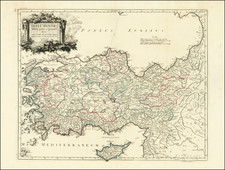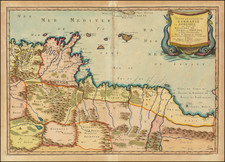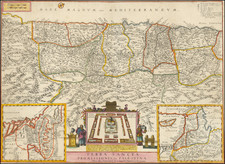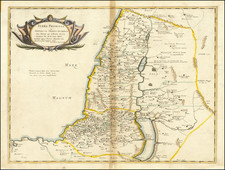Fascinating map depicting an eclipse in the year 603 BC, which was famous for ending a war between the Medians and the Lydians.
It should be noted that the date given in the map does not correspond with the date given on the ma.
Traditionally regarded as the first Western philosopher and mathematician, Thales of Miletus lived c. 585 BCE. He accurately predicted the solar eclipse of May 28, 585 BCE and was known as a skilled astronomer, geometer, statesman and sage. Thales, it is said, was the first to ask the question, "What is the basic 'stuff' of the universe" and, according to Aristotle, claimed the First Cause was water because, among other attributes, water could change shape and move while still remaining unchanging in substance. There are no known writings by Thales and all that is known of his life and work is through what we have written about him by others.
The Medes were an ancient Iranian people who lived in an area known as Media (North-western Iran and south-east Turkey) and who spoke a northwestern Iranian language referred to as the Median language.
From the 10th to late 7th centuries BCE, the Medes and Persians fell under the domination of the vast Neo-Assyrian Empire based in northern Mesopotamia, but which stretched from Cyprus to Ancient Iran, and from the Caucasus to Egypt and Arabia. Assyrian kings such as Tiglath-Pileser IV, Sargon II, Sennacherib, Esarhaddon, Ashurbanipal and Ashur-etil-ilani imposed Vassal Treaties upon the Median and Persian rulers, and also protected them from predatory raids by marauding Scythian and Cimmerian hordes.
During the reign of Sinsharishkun (622-612 BC) the Assyrian empire, which had been in a state of constant civil war since 626 BC, began to unravel. Subject peoples, such as the Medes, Persians, Babylonians, Chaldeans, Egyptians, Scythians, Cimmerians, Lydians and Arameans quietly ceased to pay tribute to Assyria.
An alliance with the Persians, and rebelling Babylonians, Scythians, Chaldeans, and Cimmerians, helped the Medes and Persians to capture Nineveh in 612 BCE, which resulted in the eventual collapse of the Neo-Assyrian Empire by 605 BC. The Medes were subsequently able to establish their Median kingdom (with Ecbatana as their royal centre) beyond their original homeland (central-western Iran) and had eventually a territory stretching roughly from northeastern Iran to the Halys River in Anatolia. After the fall of the Assyrian Empire, between 616 BCE and 605 BCE, a unified Median state was formed, which, together with Babylonia, Lydia, and Egypt, became one of the four major powers of the ancient Near East. The Median kingdom was conquered in 550 BCE by Cyrus the Great, who established the Iranian dynasty-the Persian Achaemenid Empire.
Lydia was an Iron Age kingdom of western Asia Minor located generally east of ancient Ionia in the modern western Turkish provinces of U?ak, Manisa and inland ?zmir. Its population spoke an Anatolian language known as Lydian. At its greatest extent, the Kingdom of Lydia covered all of western Anatolia. Lydia was later the name of a Roman province.










![[ Genesis / Creation ] De Schepping der Wereldt Volgens de Beschryving van Mozes. 1 Plaat [in set with] De Schepping der Wereldt Volgens de Beschryving van Mozes. 2. Plaat](https://storage.googleapis.com/raremaps/img/small/101543.jpg)


![Natolia Detta anticamente Asia Minore . . . 1686 [Shows Cyprus]](https://storage.googleapis.com/raremaps/img/small/76765.jpg)
